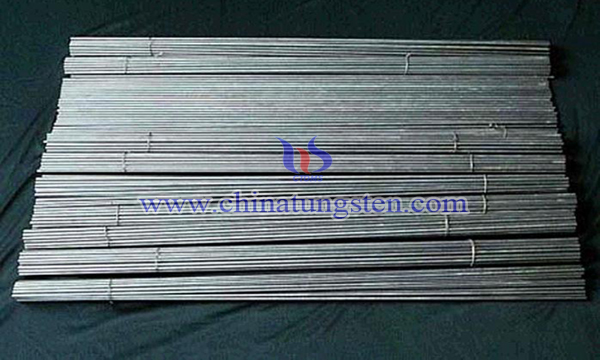Rare Earth Doped Ultrafine Tungsten Wire Preparation Process
- Details
- Category: Tungsten Information
- Published on Thursday, 19 April 2018 18:34
The addition of a certain amount of rare earth elements to tungsten can change the performance of the tungsten wire and at the same time improve the tungsten processing performance. Tungsten alloy wire and products produced by using these characteristics are mainly used for electronic tube hot wire, argon arc welding electrode, and pulse tube heating wire.

The processing of ultrafine tungsten wire belongs to refractory metal deformation processing, the uniformity of element doping is difficult to control, wire drawing processing is difficult, and the conventionally produced tungsten-niobium alloy (tungsten germanium alloy, tungsten-niobium alloy) cannot be processed to the filament of Φ0.8mm or less (especially Φ0.3mm or less). The main reason is that the production process of the alloy billet is backward, the billet content of the produced billet is too high, the additive added is not uniform, and the density is inconsistent.
A method for improving the processing of rare-earth-doped ultra-fine tungsten filaments is as follows:
(1) Ammonium paratungstate is melted into blue tungsten oxide, then doped with K2SiO3 solution and Al(NO3)3 solution and the mixture; the content of potassium should be controlled at 50-80 ppm.
(2) The first reduction of the above raw materials between 600°C and 650°C, and the second reduction between 800°C and 850°C.
(3) The reduced raw material was pickled for 30 hours; (deionized water was washed several times so that pH = 7 was vacuum dried at 80°C-120°C)
(4) After adding the lanthanum nitrate solution to the acid-washed raw material, the mixture is sintered at 300°C-500°C and sieved. The first reduction is performed between 750°C and 800°C, and the second reduction is between 900°C and 950°C.
(5) Sieving mixing material;
(6) After compaction into a billet, low-temperature pre-burning (1100°C);
(7) Two vertical melting sinters are carried out; the first vertical melting sinter is heated to 1500-1600°C, held for 12-15 minutes, and the melting current is 80-90%. The second vertical melting and sintering is heated to 1700-1900°C, and the insulation is 12-15. Minute, fuse current 80-90%, to ensure the density of tungsten rod is 17.4 ~ 17.9g/cm3.
(8) Sequential forging, crystallization annealing, rotary swaging, recrystallization annealing, rotary swaging, drawing, and stress relief annealing.
The tungsten-niobium alloy wire produced by the above method has good plasticity, it can be processed to Φ0.30 mm or less, can be wounded and processed according to different purposes, and its use performance fully meets international standards.
- Rare Earth Manufacturer & Supplier, Chinatungsten Online: www.chinatungsten.com
- Tungsten News & Prices of China Tungsten Industry Association: www.ctia.com.cn
- Molybdenum News & Price: news.molybdenum.com.cn
- Tel.: 86 592 5129696; Fax: 86 592 5129797; Email: sales@chinatungsten.com



 sales@chinatungsten.com
sales@chinatungsten.com